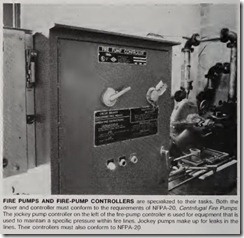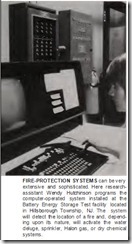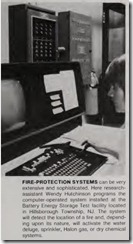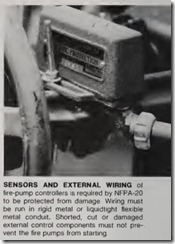Fire pumps and controllers
Here are the NFPA requirements for these units, some of the NEC rules that apply, and the equipment that is available to meet the needs.
SAFETY is increased and fire-insur ance rates are reduced when a sprinkler system is included in buildings and manufacturing facilities. Fire pumps, either electric-motor-driven or engine-driven, are integral parts of the fire-protection system. They are used where the water requirements, which can be in the thousands of gallons per minute range at high pressures, cannot be met by public supplies or gravity tanks. It is important to understand what type of equipment and starting and control devices are suitable for this service.
National Fire Protection Association (NFPA) Standard NFPA-20 is the key document for the selection and instal lation of fire pumps and their control lers. Unlike most other equipment, fire-pump controllers are required by the standard to be purchased under a unit contract along with the pump and driving means. This establishes single source responsibility for the satisfacto ry operation of the entire fire-pump system. Other NFP A rules define the requirements for fire-pump motors, controllers, installation, and testing and reference NEC sections that detail protection, feeder sizing, etc.
Motors
Squirrel-cage and wound-rotor AC motors or DC motors are permitted by NFPA-20 to drive fire pumps. Nor mally it is the squirrel-cage induction motor that will be quoted when bids are solicited for motor-driven fire pumps. If there are specific require ments for other types of motors, these must be spelled out in the equipment specifications.
The NFPA standard places responsi bility for providing a properly sized motor for the driven equipment with the pump manufacturer. The motor must have a full-load amp (FLA) rat ing that will not be exceeded under any conditions of pump load at the rated voltage and frequency of the motor. However, this does not mean that the electrical specifier has no input. If the motor has a service factor stamped on its nameplate, the FLA rating is increased to that permitted by the ser vice factor. Thus the manufacturer can utilize this service factor in meeting the requirement. If a service factor is required by the purchaser for future use, this fact must be made known to the vendor.
Other items that must be included in the specs are: the required motor enclo sure (open, dripproof, TEFC, explo sionproof, etc.); the altitude at which the equipment is to be installed if over 3300 ft; and the existence of unusual moisture or abrasive-dust conditions.
Motor nameplate markings, bearing types, and terminal-box design are all detailed for the pump manufacturer in the standard. Instructions for the care and lubrication of motor bearings are required to be supplied with each motor.
When electric motors are used in a high-rise building whose height is above the pumping capacity of the fire department, the NFP A requires that a reliable emergency source of power be provided such as an engine driven gen erator, or that standby engine-driven fire pumps be included in the fire protection system. The emergency gen erator must be sized adequately to aUow starting and running of the fire pumps as well as any other essential services connected to the generator.
Electric drive controllers
All controllers must be specifically listed for use as part of a fire-protec tion system. They include nonautomat ic and automatic types used with elec tric-motor-driven pumps.
Electric drive controllers are avail able for across-the-line and reduced voltage service. Primary-resistor, pri mary-reactor and wye-delta reduced voltage types can be specified. In addi tion, there are listed starters for jockey pumps and for limited-service applica tions. Jockey pumps are used as part of a fire-protection system to compensate for minor leaks. NFPA-20 prohibits fire pumps from being used to main tain pressure. Limited-service pumps are used to provide some additional fire protection where none is mandated by building codes. They are limited to applications where the fire-pump mo tor is 30 hp or less and only as permit ted by the authority having jurisdiction.
Controllers must have a short circuit current withstand rating at least equal to the available short-circuit cur rent for the circuit in which it is to be used. A table is included in NFP A -20 for determining the short-circuit cur rent at the controller for some limited cases. Where the table does not apply, the value must be determined by a short-circuit study. The standard pro hibits the purchase of centrifugal fire pumps until all conditions under which they are to be installed and used are determined. This can be interpreted to include the data necessary to make a short-circuit evaluation.
Details of the requirements of the isolating switch, circuit breaker, motor starter, mandatory ala-ms, drawings, markings, etc. are all included in NFPA-20. The entire unit must be assembled, wired and tested by the manufacturer. Once delivered, it be comes the responsibility of the pump manufacturer to properly integrate the various components into a package. Also, the pump manufacturer or a rep resentative is responsible for having the controller’s service personnel on the site for adjustments, repair during the warranty period, and for testing after installation.
Those designing the fire-protection system and specifying the controller have a significant role to play in the selection process. If it is known that the fire pump is located in an unat tended area, remote alarms and signals must be provided at a point of constant attendance. A source of separate reli able voltage (125 V or less) must ener gize alarms indicating loss of line pow er and fire-pump motor running condi tions. This need must be included in the specs because the controller manu facturer must provide the proper con tacts for actuating the alarms. To avoid possible misunderstanding with the authority having jurisdiction who approves the installation when com pleted, controller manufacturers can provide alarm panels that have been approved for installation in remote locations.
The choice between automatic and nonautomatic control of the fire-pump motors depends upon the protection system design. However, the automatic controller-which is normally started by a pressure switch sensing low line pressure -must also be manually oper able. The controller manufacturer will provide the needed equipment to satis fy the standard’s requirements when either of the methods is selected. However, if some other automatic means is included in the fire-protection sys tem-such as the operation of a deluge valve-this fact must be mentioned in the spec so that the controller vendor can accept this remote start signal. The signal must be in the form of a nor mally closed contact on the fire-protec tion system.
When more than one motor-driven fire pump is included in the system, the pumps must be started in sequence with intervals of 5-10 sec between them. The manufacturer must be aware of this so that the proper timing relays can be included in the control ler.
Manual or automatic shutdown of the pumps can be specified. When only one pump is used and it is the sole supply of the system, manual shut down after automatic start is mandato ry. When automatic shutdown after automatic start is specified, timers must be included in the controller to allow the pumps to run for a set period of time after the automatic start condi tions have corrected themselves.
Diesel engine drives and controllers
Engine drive selection for these types of fire pumps requires little elec trical input. All engines listed for fire pump service must have the starting and monitoring devices required by NFPA-20, with all components wired to the terminals in an engine-mounted junction box. The terminal-block num bering must match those of the engine’s controller. However, selection is required of the two batteries that are mandated for an electric-start engine. The choice is between lead-acid or nickel-cadmium batteries and whether the voltage is to be 6 or 12 V.
Specifications for engine-driven fire pump controllers should include a list of options that …re desired beyond the standard items required by NFPA-20. The most critical item is whether the battery charger should be part of the controller. Because of specific monitor ing and sequencing requirements man dated by the standard, integration into the controller is preferable but is gen erally offered only as an option. There are specific requirements for certain pilot lights and alarms that must be supplied with the equipment, but units that are to be mounted in unattended locations must have remote signals and alarms at a point of constant atten dance. Listed panels that meet the needs of engine-driven fire-pump in stallations are available. The controller manufacturer must be aware of remote indication or operation needs. In addi tion, the requirement for timers needed for sequence starting of protection sys tems that include more than one engine-driven pump must be listed in the specs.
A weekly program timer must be part of an approved controller. Its pur pose is to start and exercise the engine automatically at preset times. A n often-asked-for option is a pressure recorder mounted in the controller. This assures that a record of engine startup is available. Many other such options are usually offered by con trol ler vendors for convenience of opera tion, maintenance, or to meet require ments set by the authority having jurisdiction for approving a fire-pro tection system.
Some design and installation considerat ions
Fire pumps are exempted from sev eral NEC rules that apply to electrical installations. For example: they may be connected to the supply sid e of the service disconn ect of the facility (Sec. 230-82, Ex. 5). Alternatively, Sec. 230- 2, Ex. 1 permits fire pumps to be fed f rom a service separate from that of the building. In this case, a permanent plaque must be mounted at each ser vice-en trance location that identifies the other location an’d the extent of the electrical system it feeds. When the fire-pump controller acts as the ser vice-entrance equipment, it must be listed for that purpose.
Reliability of the service to the fire pump is very important. The utility line or an onsite generation facility must be designed and arranged so that there is little or no chance of interrup tion of the service. If this is not possi ble, the fire pump must be fed from both sources or from either of them along with an emergency generator. The two sources should be run by sepa rate routes or in such a way that dual f ailure at one time is only a remote possibility . Underground routing is particularly recommended. An auto matic transfer switch located in the fire-pump room must be included in the design. NFPA-20 requirements for th e design and application of the switch must be followed.
The feeders to the fire pump must not be routed through other buildings. The “outside the building” require ment can be satisfied by enclosing the circuit conductors in 2 in. of concrete or an equival ent 1-hr fire-resistance rated protectiv e arrangement.
N FPA-20 does not recommend that voltages above 600 V be used for fire pumps. Where this limitation is im practical, the use of higher voltage may be acceptabl e (to the authority having j urisdiction). Receiving this waiver may be difficult because HV control lers for fire-pump service are not listed. This means that in many cases the distribution voltages within a facil ity must be stepped down. This makes the NFPA rule against having a dis connecting means as part the fire feed er circuit difficult to apply rigidly. Siz ing of feeders must be per the applica ble NEC Article 430 rules.
Fire-pum p motors and their control lers must be installed so that the cur rent-carrying parts are a minimum of 12 in . abov e th e floor . Batteries req uired to start diesel-driven fire pumps must also be mounted on racks at an elevation that will prevent them from being flooded by water.
The controller must be located as close as possible to and within sight of the motor or engine. NEC Article 100 defines “within sight of” as being visi ble and not more than 50 ft distant.
Suitable means must be provided to maintain the temperature of a fire pump house or room above 40°. This minimum requirement may have to be increased if the driver is a diesel engine. The manufacturer’s recommen dations on room temperature and the need for water and oil temperatures must be followed. Ventilation, lighting, and fixed or portable battery-operated emergency lights must also be provided.
Fire-pump control circuits are criti cal items. NEC Article 430, Part F, thus exempts them from the require ments for overcurrent protection of the wiring and control transformers. Cir cuits that extend beyond the controller must be designed so that breakage or shorting of wire and equipment or loss of power may start the pump, but in no case must it prevent the units from starting. The wiring must also be pro tected against mechanical injury by being installed within rigid or liquid tight flexible conduit.
A n additional item should be noted. The 1983 version of NFPA-20 has dropped a provision that previously had permitted the continued operation of existing fire pumps that complied with the NFP A standard applicable at the time they were built .



